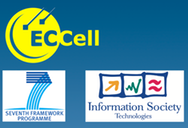ECCell is not trying to produce an abstract computational engine able to compute with silicon on abstract problem solving. It is trying to provide information intensive ICT for complex nano-embedded problem solving.
Current IT hardware is efficient but has limited adaptability. We are now used to thinking about smaller and faster personal computers, and even collections of smart systems interacting in ambient systems. The idea of a personal construction system for computers is less familiar, with reconfigurable FPGA technology having come closest to giving users programmable control over their processing hardware. The basic tenant in ECCell is that the complexity of the loop linking information processing with computer system construction dictates the limits to adaptability of IT technology. Cells are the smallest biological units which close this loop. What are the smallest technical units capable of reliably constructing variants of themselves? In ECCell we will approach such entities with electronic chemical cells (admittedly making use of the temporary crutch of an computer implemented local digital electronic feedback system)
An additional potential application of self-replicating systems is the long-term-storage of data. Current technologies can guarantee the storage of data up to about 50 years. Longer term storage is only possible via print or micro-fiche media. On the other hand, conserved regions in the DNA easily comprise several million years of history. If huge amounts of data have to be stored for long periods then storing the information in DNA or other strands in artificial cells can solve this problem. The only real challenge with such an approach is that the information stored somehow has to contribute to the surviving of the artificial cell otherwise evolution immediately will eradicate this information. As part of this project such coupling of externally provided information (data) and the life-cycle of artificial cells should be investigated. The solution not only would help in building extra-long-memory capacities but in addition to solve the problem of information-storage in potentially unreliable systems.
